Trek FX+ 7S Review | Lightweight, Yet Feature-Loaded
Quiet, light, and packed with premium features—this stealthy city bike feels more like a regular bike than just about anything we’ve ridden.
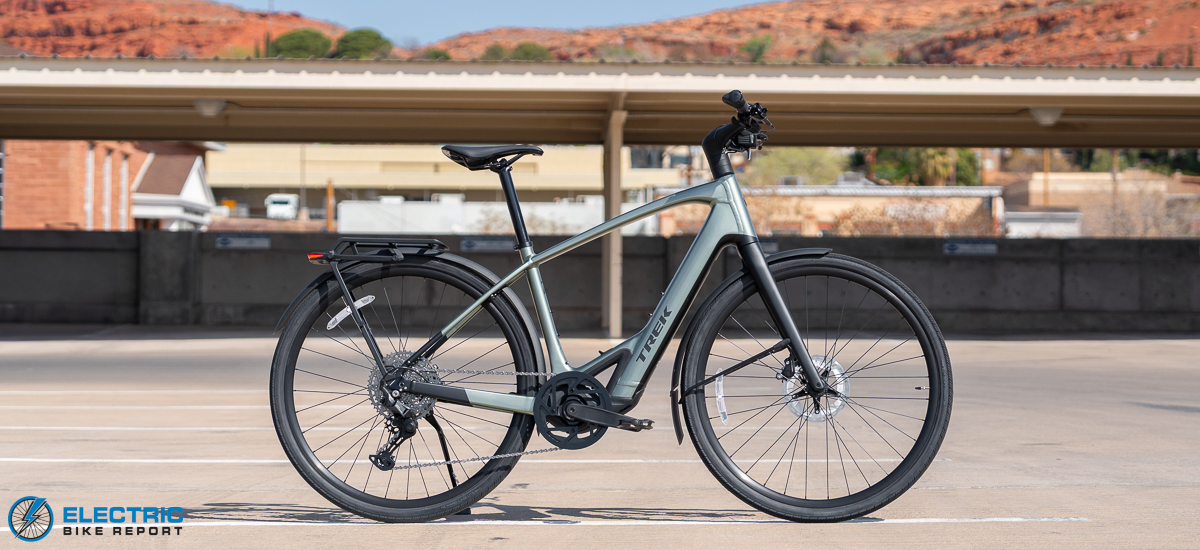
City commuter e-bikes are prized for being lighter, quieter, and more agile than other e-bike styles. They also tend to fly under the radar, with a more stealthy look that doesn’t immediately scream “e-bike” thanks to fewer obvious giveaways.
Trek’s FX+ 7S isn’t just trying to fit that mold—it’s aiming to elevate it, delivering a more premium and polished experience that nails those attributes and then some.
It starts with the motor. The TQ HPR50 uses a fundamentally different construction than most e-bike drive systems, giving the FX+ 7S an ultra-natural feel and keeping it whisper-quiet. It’s a motor that complements active riders by helping you go faster and climb better without replacing the personal satisfaction of putting in the effort.
Handling is another highlight. With four sizes available—or eight if you count the mid-step frames—the FX+ 7S offers well-balanced geometry that strikes a nice blend between active and comfortable riding. A carbon fork further improves the experience by keeping weight low and soaking up road vibrations better than standard aluminum would.
The design is clean and thoughtful, from the internally routed cables to the carefully constructed frame. The bike weighs close to 40 pounds and even includes a built-in grab section that makes carrying it upstairs much easier.
There are several standout features you don’t often see at this level, like a Quadlock mount integrated into the stem that can charge your phone (with a compatible case), and an app that pulls in some bike computer functions. It’s a great setup for riders who aren’t just commuting (though it’s great for that) but also serious about tracking fitness goals.
All in all, the FX+ 7S is a seriously impressive package that should appeal to a wide range of riders who want an active experience and are willing to pay a little extra for higher-end performance and features. Check out the testing sections below for all the details.
 Pros
Pros- Exceptionally Natural Ride Feel – The TQ motor is one of the quietest we’ve tested, with smooth, responsive engagement that enhances your effort without overshadowing it.
- Lightweight Build – Our size L tester weighed just 42 lbs, making the bike easy to carry, store, and nimble on the road.
- Smart Tech Integration – The Trek Central app adds detailed ride tracking and connectivity, while the Quadlock-compatible stem lets you wirelessly charge your phone on the go.
- Responsive, Confident Handling – Stable geometry and excellent traction make cornering at speed feel controlled and fun without being twitchy.
- Sleek, Refined Design – Clean internal cable routing, integrated lighting, and a discreet display give the bike a polished, modern look.
- Broad Sizing Options – Both high-step and mid-step versions come in four sizes each, for a total of eight frame options to suit a wide range of riders.
- Optional Range Extender – The stock 360Wh battery is solid for most rides, and the available range extender boosts capacity by 44% for longer outings.
- Fast Charging Included – A 4A charger comes standard and quickly refills the smaller battery, adding convenience and value.
- Advanced Ride Metrics – The Trek app supports heart rate monitors, tire pressure sensors, and tracks rider wattage, plus includes solid navigation tools.
 Cons
Cons- While great for looks, internal routing can make servicing the bike more complicated.
- The built-in display is cleanly integrated but sits low on the frame, making it harder to read at a glance. That said, pairing your phone via Quadlock and the Trek Central app creates a better visual alternative.
- Battery: TQ 360Wh, 160Wh range extender availabe
- Charger: TQ 4A charger
- Display: TQ LED display with Bluetooth & ANT+ connectivity
- Motor: TQ-HPR50, 50 Nm, 250-watt maximum continuous rated power, 300-watt peak power
- Headlight: Spanninga GLOW XE for e-bike
- Taillights:Herrmans H-Black MR9-E
- Pedal Assist: Torque sensor, PAS 1-3
- Claimed Range: 50 miles
- Throttle:N/A
- App:Trek Central
- UL Certification:UL 2849
- Claimed weight: 41.12 lbs (M)
- Tested Weight: 42.6 lbs (L)
- Rider height range: 5’1” – 6’6”
- Rear rack capacity: 55 lbs.
- Total payload capacity: 300 lbs.
- Brakes:Shimano hydraulic disc, RS600 lever, RS405 2-piston caliper, 180mm front rotor, 160mm rear
- Fenders:Trek FX+ 7 Rear Fender
- Fork:FX+ 7, carbon legs, hidden fender mounts, flat mount disc, internal routing, 100×12 thru axle
- Frame: Alpha Platinum Aluminum, internal cable routing, dealer removable battery, rack & fender mounts, post mount disc, kickstand mount, Highstep and Mid-step frames, dropper post compatible.
- Drivetrain:Shimano CUES LG400, LINKGLIDE, 11-48, 10-speed, 46t chainring
- Grips: Bontrager Satellite Elite, alloy lock-on
- Saddle: Bontrager Verse Comp, steel rails, 165mm width
- Handlebar: Bontrager Integrated handlebar/stem, 15mm virtual handlebar rise, S-M 640mm width, L-XL 680 mm width, 0-degree stem rise, 90mm stem (virtual) length
- Kickstand: Adjustable length rear mount alloy kickstand
- Pedals: Flat
- Tires: Bontrager H2 Hard Case Lite, wire bead, 30 tpi, 700x40mm
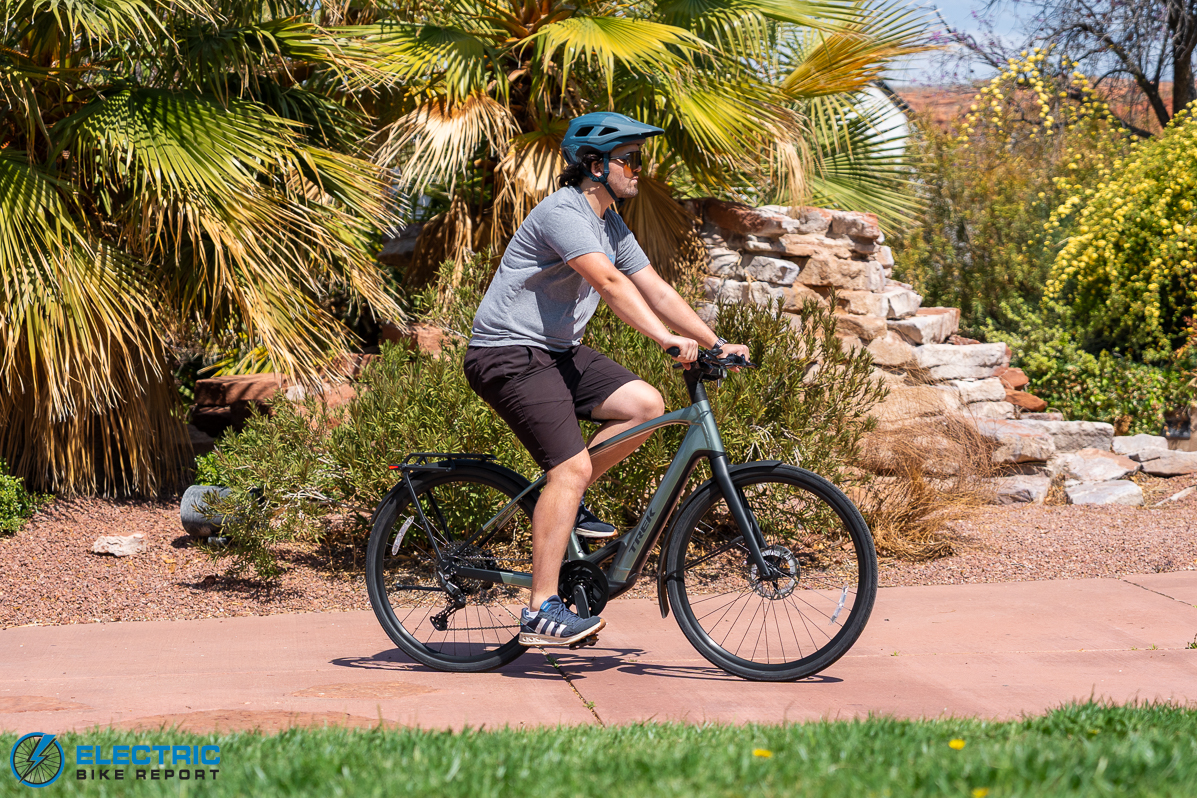

The TQ motor has a unique proprietary construction that makes for a really quiet and natural-feeling ride.
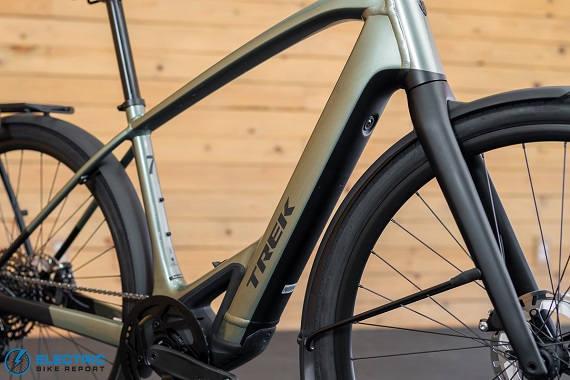
The smaller 360Wh battery keeps the downtube relatively small and sleek looking, and the bike’s got full UL 2849 & 2271 ratings.
Trek FX+ 7S Review: Speed Test
The TQ HPR50 mid-drive on the FX+ 7S is marketed as a subtle but effective ride booster—and honestly, that might be underselling it. Its construction differs from the typical belts and planetary gears used in most motors. Instead, it uses a harmonic pin ring system, which relies on fewer parts to deliver comparable torque and wattage. The result? A motor that’s shockingly quiet and incredibly natural-feeling.
You can see in the graph above how speed output varies across the three PAS levels. But here’s the wild part: even though the results differ, each level feels nearly identical while riding. That speaks to just how smoothly and consistently this motor delivers power.
I’d go so far as to say this might be the quietest motor I’ve ever ridden. The acceleration is so smooth that it’s easier to measure than to actually feel. You can see your own wattage—and how much the motor is contributing—on the bike’s display or within the Trek Central app. Sure enough, it can supply more than double your output. But during the ride itself, the assistance is nearly undetectable.
The only moment I really noticed the motor at work was when switching from high assist directly down to low without stopping in between. There’s a bit of added strain in the legs in that moment—more noticeable than any “boost” felt when moving up in the assist level. Honestly, that’s one of the highest compliments I can give: you don’t feel it working, but you see the results in your speed, stamina, and reduced effort.
The motor tops out at 300W and will absolutely help you go faster, but what it really does is take the edge off. You might find your heart rate 15–30 bpm lower than it would be for the same pace on a traditional bike. So, if you’re the kind of rider who enjoys a workout but wouldn’t mind a little help, this motor is a fantastic way to enhance—not replace—your effort.
One added perk is the motor customization available through the Trek app. You can fine-tune the power output for each assist level to suit your style better. Personally, I found the default settings to be spot-on, but it’s great to have the option to dial things in if you want more oomph or to stretch your range further.
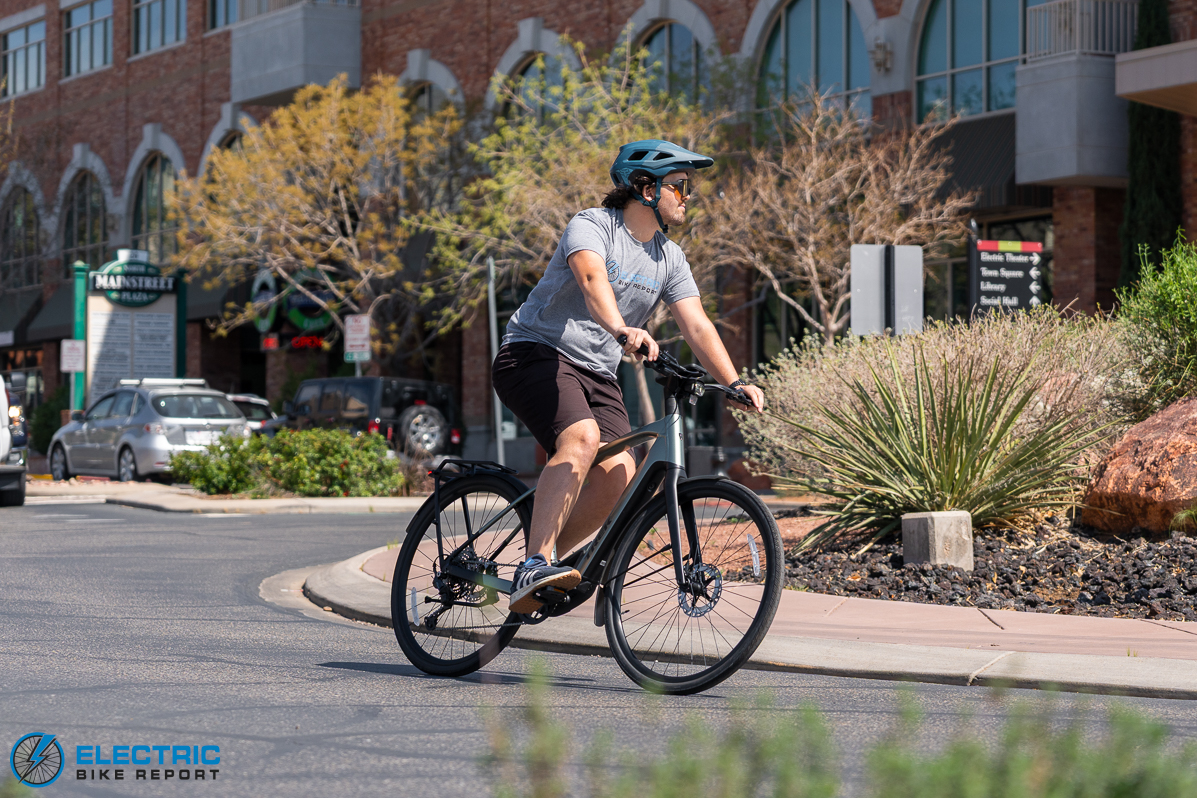
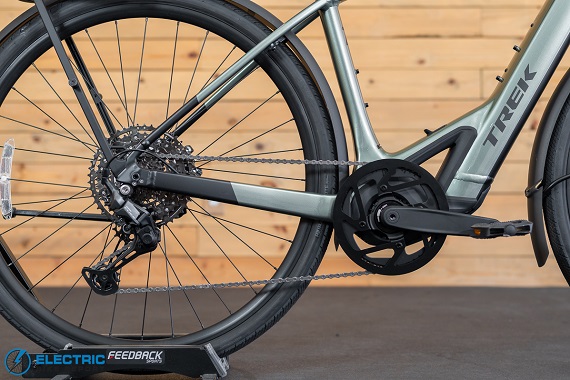
The Shimano CUES drivetrain shifted nicely, had an adequate range for climbing and quick speeds, and has better longevity than most systems.
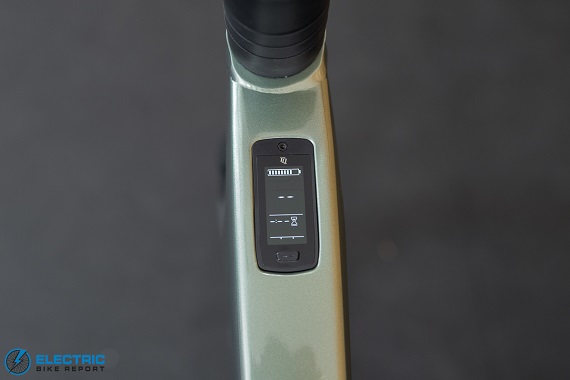
The bike has sleek integration of the display. Since the effective top tube length is on the short side, you have to look pretty low to see it, so we recommend using your phone as a display if you can.
Trek FX+ 7S Review: Range Test
One way Trek keeps the weight down on the FX+ 7S is by using a more modest battery setup. The 360Wh battery is neatly integrated into the downtube, blending in well and adding minimal bulk—but it is on the smaller side. That said, mid-drive motors tend to be more efficient than hub drives, as they work with the bike’s drivetrain and don’t have to work as hard on hills.
In our range tests—both conducted using the standard power settings and keeping speeds near the 20 mph path limit—we saw 18.78 miles on high assist and 39.23 miles on low.
Those numbers land pretty squarely in the “average” range. They’re on par with other lightweight city e-bikes we’ve tested, both in terms of mileage and overall efficiency. Looking at watts-per-mile (a more reliable comparison metric than just range, similar to MPG for cars), the FX+ 7S landed right at the class average: 9 WPM in low power and 18 WPM in high.
If 19 to 39 miles doesn’t sound like quite enough for your rides, Trek offers a range extender that mounts in place of one of the bottle cage bosses. It adds another 160Wh—boosting total battery capacity by 44%. Based on our testing, that would push your estimated range to somewhere between 27.13 and 56.5 miles, depending on the usual factors that affect range.
Trek FX+ 7S Review: Hill Test
The Trek FX+ 7S is designed to enhance—not replace—your own pedaling power. It offers a helpful boost while staying mostly in the background, keeping you engaged and letting you get a workout in.
When we put it through our standard Hill Test at the Hell Hole trail, the FX+ 7S made it to the top in exactly two minutes, averaging 9.0 mph. That’s on the lower end compared to other bikes we’ve tested (seven seconds slower than our current city bike average), but it aligns with what this bike is all about.
If it sounds like I’m making excuses for a slower hill time, I’m not. It’s just a different kind of ride experience—like comparing sushi and pizza. Both are great but for different reasons. This bike takes a more natural, rider-forward approach to climbing, and it delivers on that intent, where other bikes focus on making things as easy as possible with less natural-feeling power.
Even Trek leans into this messaging. On the FX+ 7S product page, you’ll see talk of its quiet ride, sleek design, and subtle assist. But when it comes to hills, these snippets from their marketing really sum it up:
“Sleek. Light. Quiet. FX+ 7S is an elegant city e-bike made to blend into the environment with smooth assist that feels like an extension of your own power… (It’s for you if) You want quiet support that makes light work of big hills without taking you out of the element.”
I’d take that one step further: This is the kind of e-bike that can win over longtime cyclists who’ve been hesitant to go electric. It adds to your ability but never overwhelms it. It’s a great option for those who still want to feel the effort but with less strain.
And if you do want more climbing punch from Trek’s lineup, there are options. The more budget-friendly FX+ 2 uses a hub motor that zips up hills a bit quicker, and the Allant+ 8S offers a higher-performance setup for riders who prioritize power.
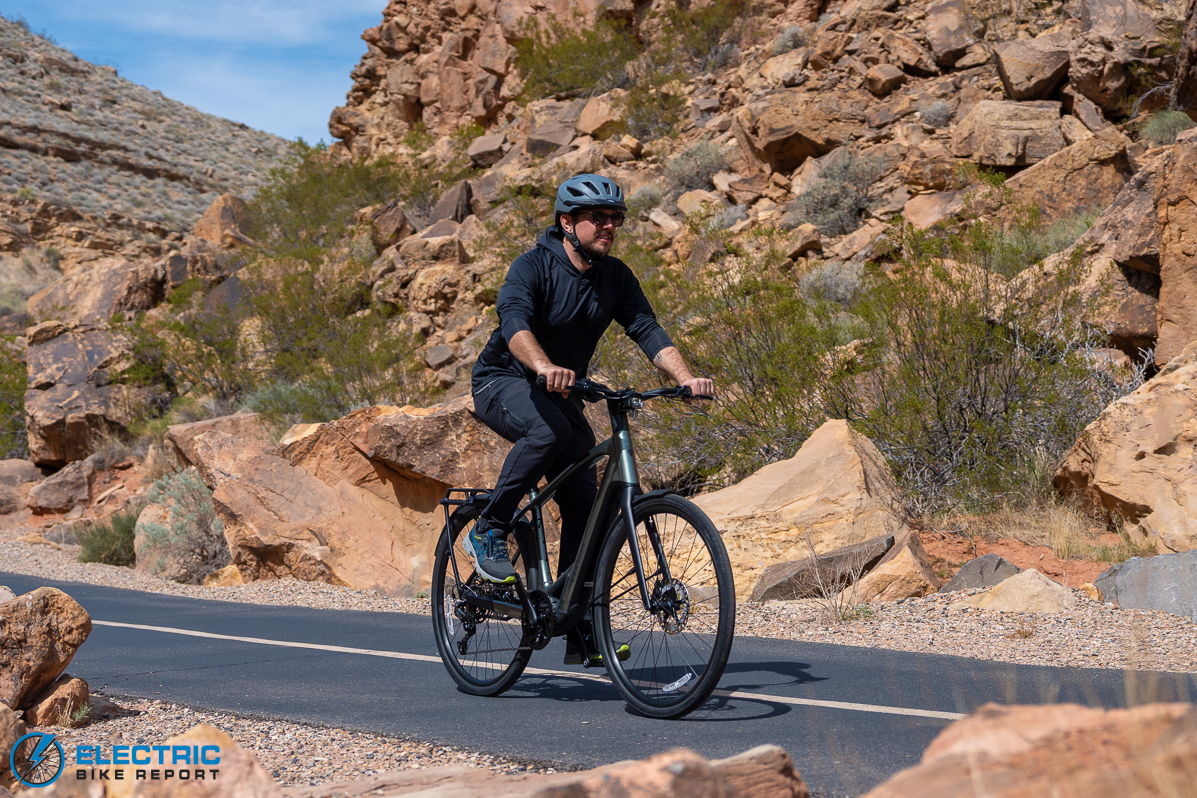
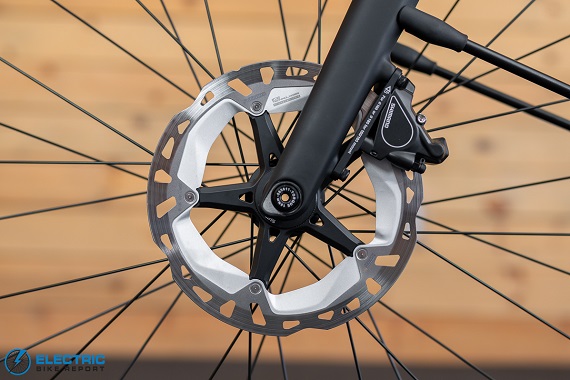
The braking performance was stellar by city bike standards, and it helps pad the overall value.
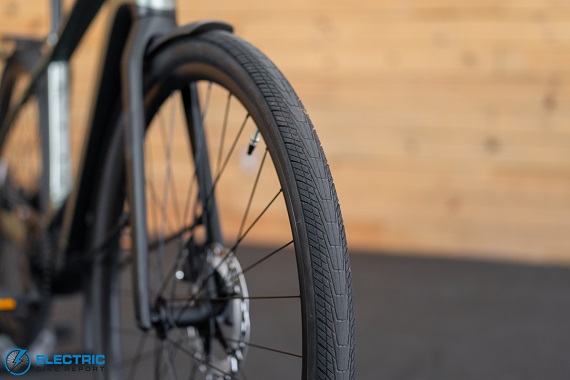
The tires have a good road tread that feels confident into corners with nice traction.
Trek FX+ 7S Review: Brake Test

The FX+ 7S comes well-stocked in the braking department. Many city commuters—being among the featherweights of the e-bike world—get away with smaller rotors or mechanical disc brakes. But Trek doesn’t take that shortcut here.
Instead, they’ve outfitted the FX+ 7S with a solid Shimano hydraulic brake setup, including a 180mm front rotor and a 160mm rear. It’s a more robust system than you’d expect for a lightweight bike, and it absolutely pays off.
In our brake test, the FX+ 7S recorded an average stopping distance of 21’10”. That’s nearly two feet shorter than the current average for similar city commuters, which is about 23’6”.
The brakes perform well beyond emergency stops, too. On longer, sustained downhills, they handled great under light feathering, maintaining consistent control without fade or fuss. Whether in measured testing or everyday riding, the braking performance held up across the board.
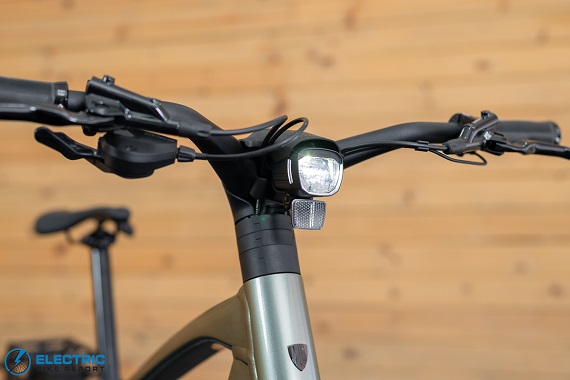
The 120-lumen headlight is helpful for riding at dusk, and integrates nicely into the stem shroud.
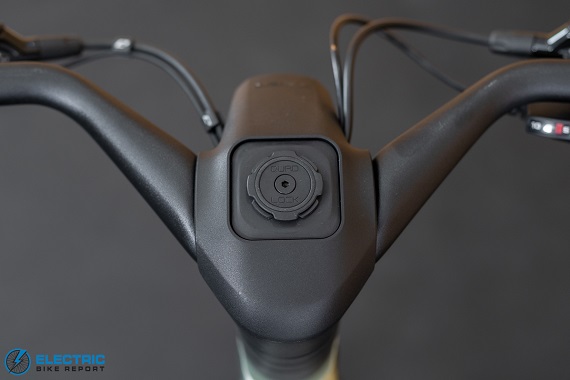
I didn’t actually know this would charge my phone when I first tried it so that was a true delight! The Quadlock mounts turns your phone into a nice source of turn-by-turn navigation.
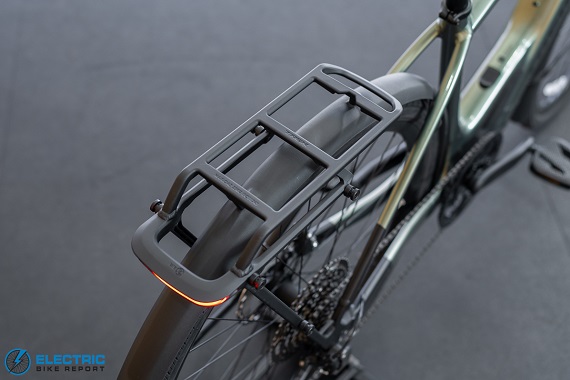
The MIK rack can hold a lot of weight up to 55 lbs, but that’s more than the bike itself, so it will alter the handling a lot when fully loaded. We loved the quick mounts on the side that work with several different panniers.
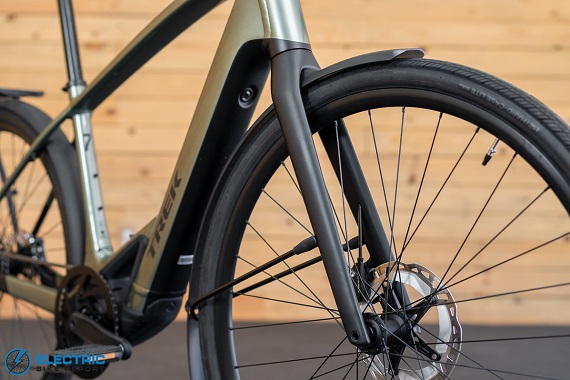
The carbon fork aids in the bike’s nice handling, and we really appreciated how they tied the black accents of the bike in with the black carbon fork.
Trek FX+ 7S Review: Ride Quality
Shifting from the quantitative side of testing to the qualitative, the FX+ 7S really earns its premium badge. There are a lot of thoughtful touches—both big and small—that come together to make this a genuinely enjoyable ride.
The handling feels crisp and well-balanced. The Shimano CUES derailleur shifts smoothly, and the gear ratio has a great gear range for both climbing and reaching higher speeds. It includes Shimano’s Linkglide, which beefs up the drivetrain for added durability without sacrificing shift quality.
The 700x40c Bontrager tires offer solid traction and a more cushioned ride by road standards, thanks to the width. At 30 TPI, the rubber is pretty dense and durable. I loved to see that the wheels are tubeless-ready, so you can drop the pressure for an even softer ride without the risk of pinch flats.
The carbon fork not only helps keep the overall weight down but also reduces road vibrations better than aluminum, making the ride feel pretty smooth without sacrificing the responsiveness of a rigid fork.
The handlebar has limited adjustability, but it feels well-sized for quick, agile handling. The integrated Quadlock stem mount is a standout—it wirelessly charges your phone when using a compatible case, letting you run Trek’s turn-by-turn navigation without draining your battery. The internally routed cables through the headset elevate the bike’s sleek aesthetic, though they may complicate future maintenance.
The integrated top tube display gives you the essentials if you don’t want to use your phone. It’s nicely blended into the frame, but i’s small and positioned low with the bike’s effective top tube being on the short side—so it’s more like checking your knees than a quick glance between your wrists—so we’d recommend a Quadlock case to take full advantage of the mount for a better display experience.
A little more details on the Trek Central app: you can fine-tune motor settings, sync with heart rate monitors or digital tire pressure gauges, and view your personal and bike wattage outputs. It essentially acts as a bike computer, which is a great bonus for riders who want to track performance.
The rear MIK rack works with a wide range of quick-mounting accessories, and the integrated brake light helps keep you visible. There are also two bottle cage mounts, which is especially helpful if you’re using one for the optional range extender.
Touch points are mostly solid. The grips are soft and comfortable, and the Bontrager Verse Comp saddle—while supportive—might feel a bit firm for less seasoned riders. The plastic pedals were grippier than expected, but they’re plastic, and they’re probably the one component that feels out of place on such a polished bike. That said, pedals are among the easiest parts to upgrade if you want to.
As for the frame, it’s a sleek sight. There are eight total size options—four each in the high-step and mid-step versions—and while there are only two colorways, our green test bike looked fantastic, with black accents tying together the fork, downtube underside, and chainstays.
And as a final thoughtful touch, the frame has a type of grab handle near the crankset—a small but super handy feature for apartment dwellers or anyone needing to haul the bike up stairs.
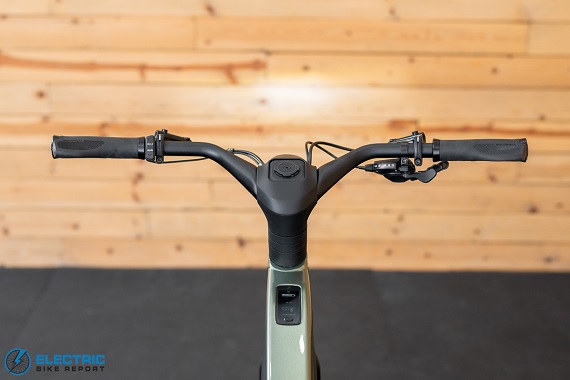
The unique V shape of the handlebar lengthens the reach, but still gives the bike good body positioning, and the handling felt more precise than twitchy.
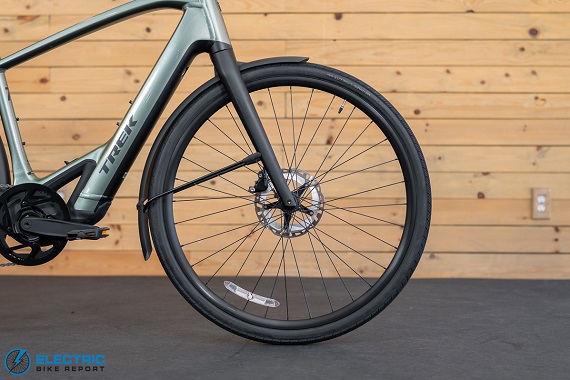
As a welcome sight when the fenders are a little longer to keep splashes off the rider.
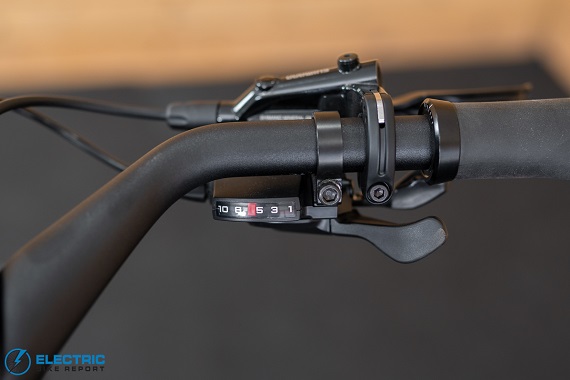
The shifter worked reliably each time, and the range across the 10-speed cassette felt very practical.
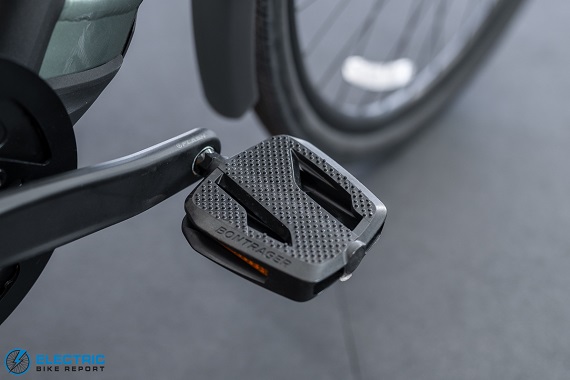
The pedals were pretty grippy, but the all plastic look suck out on an otherwise premium appearence.
Trek FX+ 7S Review: Summary / Where to Buy
Handling is another standout. The geometry is spot-on, giving the bike a responsive, agile feel while still feeling planted and stable at speed and through corners.
Thoughtful features like the Trek Central app and the integrated Quadlock mount round out the experience. They’re the kind of extras that add real value for everyday riders and make the bike that much more enjoyable to live with.
There are plenty of good lightweight e-bikes out there—Trek’s own FX+ 2 is a more budget-friendly example if you’re just after a lightweight commuter.
But if you’re looking for a ride that delivers a top-tier natural feel, adds smart features you’ll actually use, and elevates your daily ride, the FX+ 7S delivers a standout premium experience.
Happy Riding! Make sure to let us know if you have any questions or if you think we left anything out in this review of the Trek FX+ 7S down in our comments section.



